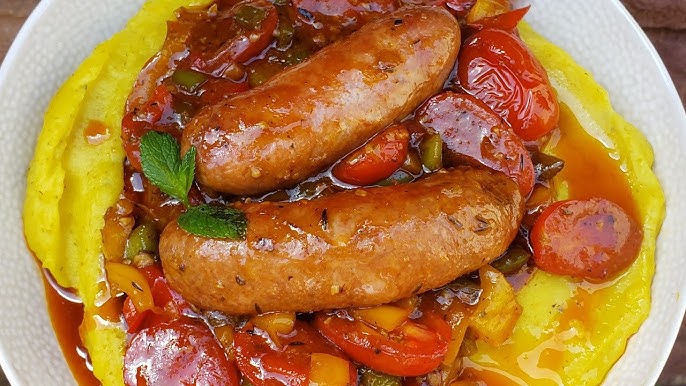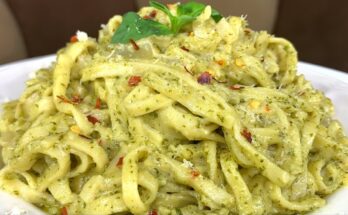Sausage Food Recipe: Is there anything more satisfying than the sizzling sound of sausages cooking on a pan? Whether you’re a home cook or someone just starting in the kitchen, a good sausage recipe can be your best friend. They’re rich, hearty, and oh-so-versatile. You can grill, fry, bake, or even boil them, and they still come out delicious. In this guide, we’re diving deep into one of the easiest yet most flavorful sausage food recipes you’ll ever try.
Sausages are beloved around the globe. From spicy Italian links to smoky German bratwursts and sweet breakfast sausages, they’re everywhere. And for good reason—they’re easy to cook, loaded with flavor, and fit into almost any cuisine style. Today, you’ll learn how to make a comforting, classic sausage dish from scratch, with detailed steps, tips, and even plating ideas. So roll up your sleeves and let’s get sizzling!
Ingredients You’ll Need
Before we even think about turning on the stove, let’s talk ingredients. Having everything ready beforehand not only saves time but ensures your cooking process goes smoothly.
Essential Ingredients:
- 4-6 pork or beef sausages (choose your favorite variety)
- 2 tablespoons of olive oil
- 1 medium onion, thinly sliced
- 2 cloves of garlic, minced
- 1 bell pepper, sliced (any color you like)
- 1 can of diced tomatoes (14 oz)
- Salt and pepper to taste
- 1 teaspoon paprika
- 1 teaspoon Italian seasoning or dried oregano
Optional Additions:
- 1/2 cup of red wine – for a richer sauce
- Fresh basil or parsley – for garnish
- Chili flakes – if you like it spicy
- Mushrooms – add a nice earthy flavor
- Cooked pasta or rice – as a base
These ingredients are easy to find and give you a solid foundation to tweak based on your preferences. Want it spicy? Add hot sausages. Prefer a lighter dish? Go with chicken sausage. It’s all up to you!
Kitchen Tools and Prep
Let’s talk tools. Having the right equipment makes cooking more efficient and enjoyable. Here’s what you’ll need to whip up this delicious sausage recipe.
Must-Have Tools:
- A large skillet or frying pan – for even cooking
- A sharp chef’s knife – for clean cuts
- Cutting board
- Wooden spoon or spatula – for stirring
- Measuring spoons – for spices and oil
Prep Steps:
- Slice the onion and bell pepper and set them aside in separate bowls.
- Mince the garlic.
- Open your can of tomatoes and drain slightly if you prefer a thicker sauce.
- Measure out your spices and oil.
- Pat the sausages dry with a paper towel to ensure they brown nicely.
Getting this prep work done upfront helps avoid a chaotic kitchen later. Trust me, a little prep goes a long way when you’re dealing with sizzling oil and juicy sausages.
Step-by-Step Sausage Recipe Guide
Now, let’s get to the good stuff. Follow these steps carefully and you’ll end up with a sausage dish that tastes like it came from a gourmet kitchen.
Step 1: Preparing the Sausages
Start by taking your sausages out of the fridge about 10-15 minutes before cooking. This brings them to room temperature and helps them cook evenly. Using a fork, gently prick each sausage a couple of times. This prevents them from bursting as they cook.
You can also parboil them for a few minutes in water or beer. This reduces fat and ensures they’re cooked all the way through. Once done, drain and set them aside.
Step 2: Cooking the Sausages
Heat your skillet over medium heat and add the olive oil. Once the oil is hot, gently place the sausages in the pan. Cook them for about 8–10 minutes, turning occasionally until all sides are beautifully browned.
Don’t overcrowd the pan. Give them space to sear properly. If you’ve got a lot to cook, do it in batches. Once browned, remove and set aside on a plate.
Step 3: Creating the Sauce or Sides
Now that your sausages are golden brown and resting, it’s time to bring the flavor game to the next level. Using the same skillet (don’t wash it—you want all that flavor), add a little more olive oil if needed and toss in your sliced onions. Sauté them on medium heat until they start to soften and turn golden, about 5–7 minutes.
Next, add your minced garlic. Cook it for just a minute—garlic burns quickly and you don’t want a bitter flavor. Then toss in your sliced bell peppers and let them cook for another 3–4 minutes until they’re slightly tender but still vibrant.
Now for the magic: pour in the diced tomatoes. Stir everything together, making sure to scrape up the browned bits from the bottom of the pan. That’s where all the flavor lives! Add paprika, Italian seasoning (or oregano), salt, and pepper. If you’re using red wine, pour it in now and let it simmer for a few minutes to cook off the alcohol.
Let the sauce simmer on low for about 10–15 minutes. This helps meld the flavors together into a rich, savory base that complements the sausages perfectly.
Step 4: Combining All Components
Once the sauce has thickened slightly and the veggies are tender, it’s time to bring the sausages back into the party. Nestle them into the sauce, making sure each one is coated in all that rich tomato goodness. Cover the pan and let it simmer for another 10–15 minutes on low heat.
This step ensures the sausages are cooked through completely and soak up all the delicious sauce. Stir occasionally and flip the sausages if needed to coat them evenly.
You can also take this moment to adjust your seasoning. Taste the sauce—does it need more salt? A pinch of sugar if it’s too acidic? Some extra herbs or spice for a stronger kick? Customize it to your palate.
Step 5: Garnishing and Plating
Presentation matters, especially when you’ve put your heart into cooking. Once everything’s cooked and the flavors are perfect, it’s time to serve.
Here’s how you can plate this dish to impress:
- Base it with starch – Spoon a bed of fluffy white rice, creamy mashed potatoes, or cooked pasta onto a plate.
- Layer the sausage and veggies – Place 1–2 sausages over the starch and ladle on the sauce and sautéed veggies.
- Garnish – Sprinkle freshly chopped parsley or basil over the top. A few shavings of parmesan or a drizzle of olive oil can also elevate the presentation.
Serve it hot, and watch those plates clear in no time. This dish works beautifully for family dinners, cozy date nights, or even casual meal prep for the week.
Tips and Tricks for Perfect Sausage Dishes
Let’s be real—cooking sausages might seem simple, but small tweaks can take your dish from good to restaurant-worthy. Here are some tried-and-true tips:
- Low and slow wins the race – Don’t rush cooking sausages on high heat. They’ll burn outside and stay raw inside.
- Don’t pierce them too much – A couple of pokes help with steam release, but too many will drain all the juicy goodness.
- Use the same pan – Cook your veggies and sauce in the same skillet as your sausages to keep all those savory drippings.
- Layer the flavors – Use fresh herbs at the end for brightness, and dried spices early on to build depth.
- Finish in the oven (optional) – For an even cook and crispy outside, you can pop your sausages into a 375°F oven for 10–15 minutes after browning.
Every small touch adds up. These tricks don’t just enhance flavor—they also give you that pro-chef vibe in your own kitchen.
Common Mistakes to Avoid
Even the most seasoned home chefs can slip up. When it comes to cooking sausages, a few common mistakes can lead to dry, bland, or even undercooked results. Here’s how to avoid the most frequent blunders:
- Overcooking or Undercooking: Sausages are all about balance. Overcooking makes them dry and rubbery, while undercooking is downright dangerous. Use a thermometer—sausages should reach an internal temp of 160°F (71°C) for pork or beef, and 165°F (74°C) for chicken.
- Skipping the Rest Time: Just like steak, sausages benefit from resting. Let them sit for a few minutes after cooking. This helps the juices redistribute, keeping every bite moist and flavorful.
- Using Too Much Heat: High heat can scorch the outside before the inside is done. Medium heat is your best friend—it lets the sausage cook evenly and develop a lovely golden crust.
- Crowding the Pan: If you jam too many sausages into a single pan, they’ll steam instead of sear. Cook in batches if needed.
- Neglecting the Sauce: A bland sauce can tank an otherwise great sausage. Season gradually, taste often, and adjust accordingly.
Avoid these, and you’ll be amazed at how consistently delicious your sausage meals turn out.
Nutritional Value of Sausage Recipes
Sausages can be indulgent, but they don’t have to be unhealthy. Depending on your choice of ingredients, you can make sausage recipes that are both satisfying and nutritious.
Here’s a breakdown of what you get in a typical serving (2 sausages + sauce and veggies):
| Nutrient | Approximate Value |
|---|---|
| Calories | 400–500 kcal |
| Protein | 18–25 grams |
| Carbohydrates | 15–20 grams |
| Fats | 25–35 grams |
| Fiber | 3–5 grams |
| Sodium | 800–1200 mg |
To make it healthier:
- Choose lean sausages: Look for chicken or turkey options.
- Load up on vegetables: Bell peppers, mushrooms, spinach, and zucchini add fiber and nutrients.
- Limit salt and fat: Use less oil, go easy on added salt, and avoid overly processed sausages.
Everything in moderation, right? A sausage meal, especially one made with fresh, quality ingredients, can absolutely fit into a balanced diet.
Variations and Regional Twists
One of the best parts of sausage recipes? You can find them in nearly every culture, and they all bring something special to the table. Let’s explore a few tasty variations:
- Italian Sausage with Peppers: Add fennel seeds, crushed red pepper, and use sweet or spicy Italian sausages. Serve over hoagie rolls or with pasta.
- German Bratwurst: Simmer bratwurst in beer with onions, then grill them and serve with mustard and sauerkraut.
- Spanish Chorizo: Use paprika-heavy Spanish chorizo, toss it with chickpeas and tomatoes for a smoky, rustic dish.
- British Bangers and Mash: Pair pork sausages with creamy mashed potatoes and rich onion gravy.
- Cajun Andouille Sausage: Bring the heat with andouille in a spicy gumbo or jambalaya.
These versions give you new ways to enjoy the same core concept—sausages + flavor-packed accompaniments = dinner bliss.
Serving Suggestions
Wondering what to serve with your sausage dish? You’ve got lots of delicious options, depending on your mood and the occasion:
- For a cozy dinner: Serve sausages over buttery mashed potatoes with gravy.
- For something lighter: Try a fresh side salad or roasted vegetables.
- For a hearty meal: Pile your sausage and sauce over pasta, polenta, or rice.
- For brunch: Slice cooked sausages and toss into scrambled eggs or an omelet.
- For parties: Make mini sausage skewers with peppers and dip on the side.
A quick tip: always consider color and texture when plating. A pop of green (like parsley) or a drizzle of sauce adds restaurant-worthy style.
Storage and Reheating Tips
Leftovers? Great! Sausage dishes are often even better the next day. Here’s how to store and reheat them the right way:
Storing:
- Let your sausage dish cool completely before transferring to an airtight container.
- Store in the fridge for up to 3–4 days.
- You can also freeze for up to 2 months—just separate into meal-sized portions for easy reheating.
Reheating:
- Microwave: Cover and heat on medium power in 1-minute intervals.
- Stovetop: Reheat gently over medium heat, adding a splash of water or broth to keep it moist.
- Oven: Place in an oven-safe dish, cover with foil, and warm at 350°F for 15–20 minutes.
Pro tip: don’t overheat or you’ll dry out the sausages. Just warm them enough to reach that ideal internal temp again.
FAQs about Sausage Food Recipe
1. Can I use frozen sausages for this recipe?
Yes, but be sure to thaw them completely before cooking to ensure even heating and to prevent a rubbery texture.
2. What’s the best type of sausage for this recipe?
Any type works! Pork, beef, chicken, or even plant-based sausages can be used. It’s all about personal preference and desired flavor.
3. How do I know when sausages are fully cooked?
Use a meat thermometer—sausages should reach an internal temperature of 160°F (pork/beef) or 165°F (chicken).
4. Can I make this dish in advance?
Absolutely. It stores well in the fridge for up to 4 days and reheats beautifully.
5. Is it possible to make this dish spicy?
Yes! Use spicy sausage, add red chili flakes, or toss in some fresh jalapeños to turn up the heat.
Conclusion
There’s something truly magical about a well-made sausage dish. From the sizzle in the pan to the burst of flavor in every bite, it’s comfort food at its finest. Whether you’re whipping up a quick weeknight dinner or crafting a gourmet meal for guests, mastering a classic sausage recipe gives you a flexible, crowd-pleasing tool in your kitchen arsenal.
Remember—choose good ingredients, don’t rush the process, and tweak it to suit your taste. Once you’ve nailed this basic recipe, the possibilities are endless. Explore regional versions, mix up the spices, or create a signature sauce of your own. Now go cook up something amazing—and enjoy every delicious bite.



